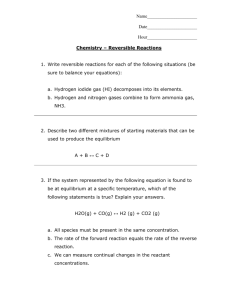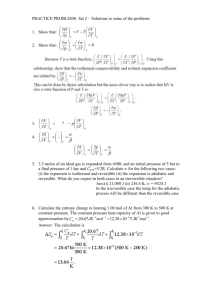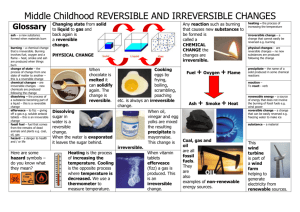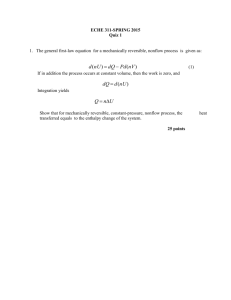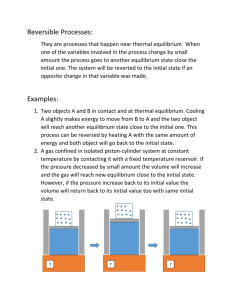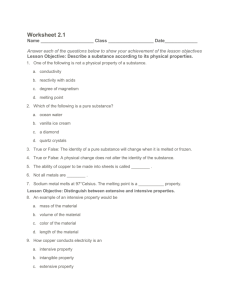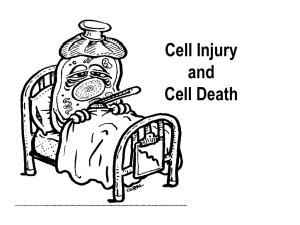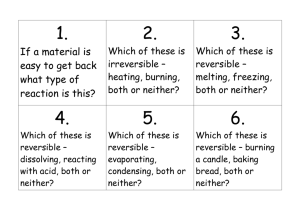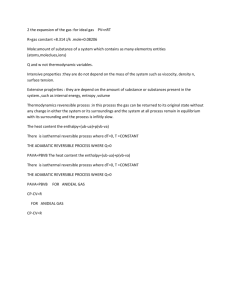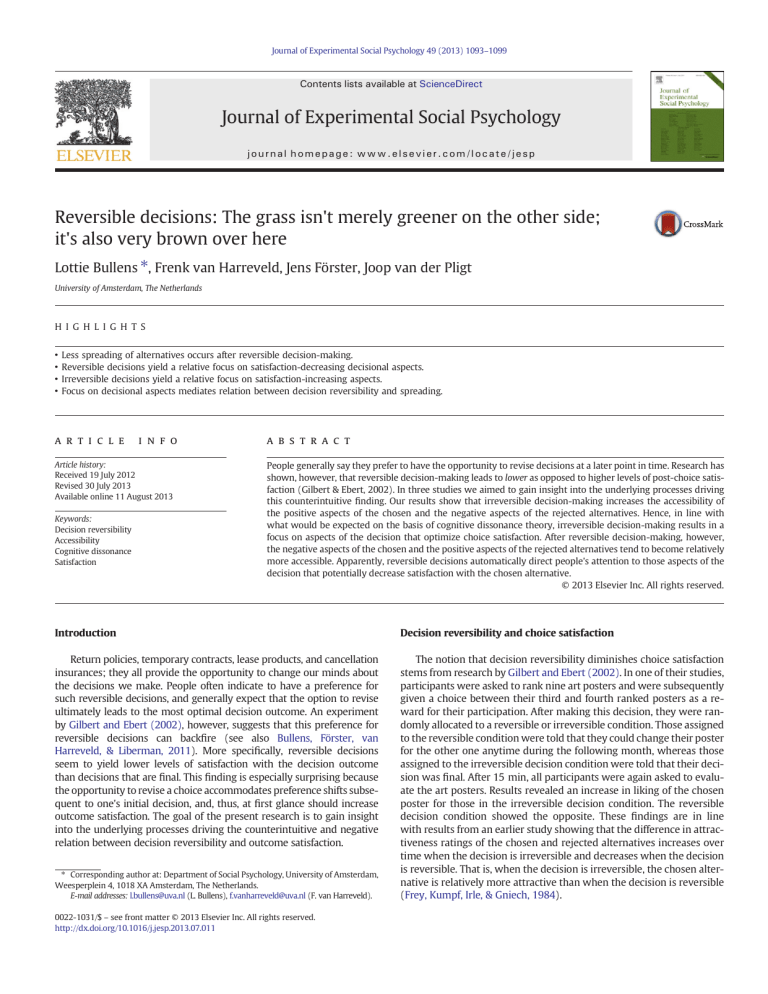
Journal of Experimental Social Psychology 49 (2013) 1093–1099
Contents lists available at ScienceDirect
Journal of Experimental Social Psychology
journal homepage: www.elsevier.com/locate/jesp
Reversible decisions: The grass isn't merely greener on the other side;
it's also very brown over here
Lottie Bullens ⁎, Frenk van Harreveld, Jens Förster, Joop van der Pligt
University of Amsterdam, The Netherlands
H I G H L I G H T S
•
•
•
•
Less spreading of alternatives occurs after reversible decision-making.
Reversible decisions yield a relative focus on satisfaction-decreasing decisional aspects.
Irreversible decisions yield a relative focus on satisfaction-increasing aspects.
Focus on decisional aspects mediates relation between decision reversibility and spreading.
a r t i c l e
i n f o
Article history:
Received 19 July 2012
Revised 30 July 2013
Available online 11 August 2013
Keywords:
Decision reversibility
Accessibility
Cognitive dissonance
Satisfaction
a b s t r a c t
People generally say they prefer to have the opportunity to revise decisions at a later point in time. Research has
shown, however, that reversible decision-making leads to lower as opposed to higher levels of post-choice satisfaction (Gilbert & Ebert, 2002). In three studies we aimed to gain insight into the underlying processes driving
this counterintuitive finding. Our results show that irreversible decision-making increases the accessibility of
the positive aspects of the chosen and the negative aspects of the rejected alternatives. Hence, in line with
what would be expected on the basis of cognitive dissonance theory, irreversible decision-making results in a
focus on aspects of the decision that optimize choice satisfaction. After reversible decision-making, however,
the negative aspects of the chosen and the positive aspects of the rejected alternatives tend to become relatively
more accessible. Apparently, reversible decisions automatically direct people's attention to those aspects of the
decision that potentially decrease satisfaction with the chosen alternative.
© 2013 Elsevier Inc. All rights reserved.
Introduction
Decision reversibility and choice satisfaction
Return policies, temporary contracts, lease products, and cancellation
insurances; they all provide the opportunity to change our minds about
the decisions we make. People often indicate to have a preference for
such reversible decisions, and generally expect that the option to revise
ultimately leads to the most optimal decision outcome. An experiment
by Gilbert and Ebert (2002), however, suggests that this preference for
reversible decisions can backfire (see also Bullens, Förster, van
Harreveld, & Liberman, 2011). More specifically, reversible decisions
seem to yield lower levels of satisfaction with the decision outcome
than decisions that are final. This finding is especially surprising because
the opportunity to revise a choice accommodates preference shifts subsequent to one's initial decision, and, thus, at first glance should increase
outcome satisfaction. The goal of the present research is to gain insight
into the underlying processes driving the counterintuitive and negative
relation between decision reversibility and outcome satisfaction.
The notion that decision reversibility diminishes choice satisfaction
stems from research by Gilbert and Ebert (2002). In one of their studies,
participants were asked to rank nine art posters and were subsequently
given a choice between their third and fourth ranked posters as a reward for their participation. After making this decision, they were randomly allocated to a reversible or irreversible condition. Those assigned
to the reversible condition were told that they could change their poster
for the other one anytime during the following month, whereas those
assigned to the irreversible decision condition were told that their decision was final. After 15 min, all participants were again asked to evaluate the art posters. Results revealed an increase in liking of the chosen
poster for those in the irreversible decision condition. The reversible
decision condition showed the opposite. These findings are in line
with results from an earlier study showing that the difference in attractiveness ratings of the chosen and rejected alternatives increases over
time when the decision is irreversible and decreases when the decision
is reversible. That is, when the decision is irreversible, the chosen alternative is relatively more attractive than when the decision is reversible
(Frey, Kumpf, Irle, & Gniech, 1984).
⁎ Corresponding author at: Department of Social Psychology, University of Amsterdam,
Weesperplein 4, 1018 XA Amsterdam, The Netherlands.
E-mail addresses: l.bullens@uva.nl (L. Bullens), f.vanharreveld@uva.nl (F. van Harreveld).
0022-1031/$ – see front matter © 2013 Elsevier Inc. All rights reserved.
http://dx.doi.org/10.1016/j.jesp.2013.07.011
1094
L. Bullens et al. / Journal of Experimental Social Psychology 49 (2013) 1093–1099
More recently, Bullens, van Harreveld, and Förster (2011) demonstrated that reversible decisions also result in higher levels of choice
regret and found this effect to be mediated by participants' cognitive
capacity. More specifically, in a first experiment, Bullens and colleagues
asked participants to make a reversible or irreversible choice between
two lotteries, and, subsequently, measured the accessibility of words
related to each of the choice options (i.e., words related to the prizes
in each of the lotteries) and unrelated neutral words with a lexical
decision task. Results revealed that relative to the neutral words,
choice-related words were more accessible for those who still had the
opportunity to change their minds, compared to those for whom the
decision had been final. Furthermore, as soon as the decision became
final for those in the reversible decision condition (i.e., after participants
had the opportunity to revise their initial decision), the relative accessibility of choice-related words decreased. These results are in line with
research showing that upon goal fulfillment the accessibility of goal
relevant constructs is reduced or inhibited (e.g., Förster, Liberman, &
Higgins, 2005; Liberman, Förster, & Higgins, 2007; Zeigarnik, 1927).
In a second study, Bullens, van Harreveld, et al. (2011) showed that
decision reversibility curtails people's cognitive resources as indicated
by the finding that participants in the reversible decision condition
had lower working memory capacity than their counterparts in the
irreversible decision condition. Moreover, reversible decision-making
increased levels of choice regret, and this effect appeared to be mediated
by participants' working memory capacity as measured with an operation span task. Altogether, these results suggest that the decisionrelated thoughts people are occupied with during the time their choice
is reversible result in lower levels of satisfaction. Previous research,
however, did not address the content of these thoughts. The latter
might play an important role in the differences in choice satisfaction
after reversible versus irreversible decisions.
Underlying mechanisms: focused attention on consonant versus
dissonant aspects
In explaining their findings regarding choice satisfaction, Gilbert and
Ebert (2002) briefly speculated about what aspects of the decision
particularly come to mind when having made a reversible choice. In
general, they suggested that the “psychological immune system” is unable to start operating when decisions are reversible. The “psychological
immune system” comprises people's fundamental tendency to restructure their views of outcomes in such a way that these outcomes are
experienced more positively. One of the most prominent theories
describing this general tendency within the decision-making domain
is cognitive dissonance theory (Brehm, 1956; Festinger, 1957). Research
on cognitive dissonance theory has compellingly shown that people
augment the attractiveness of the chosen alternative, and reduce the
attractiveness of the rejected alternative(s) (i.e., the desirability ratings
of the chosen and rejected alternatives spread apart) after making
a difficult decision. Such “spreading-apart” helps to reduce possible
bad feelings produced by cognitive inconsistencies (i.e., thoughts on
the negative aspects of the chosen alternative or the positive aspects
of the rejected alternative) people may have about the attitude object.
According to Gilbert and Ebert (2002), individuals increase the attractiveness of the chosen alternative after having made an irreversible
decision, as a way to boost choice satisfaction. However, after people
have made a reversible decision, they do not optimize their attitudes
toward the chosen alternative (see also Festinger, 1964; Frey, 1981,
1986; Frey et al., 1984; Frey & Rosch, 1984). Instead, as Gilbert and
Ebert reason, they continue to critically evaluate the chosen option
and especially pay attention to its imperfections in order to decide
whether or not to keep this alternative. When they finally decide to
stick with the initially chosen alternative, all their critical thinking
may have negatively impacted upon their satisfaction.
Although never examined directly, there is some indirect evidence
supporting the notion that decision reversibility yields people to pay
more attention to those aspects of the choice alternatives that are
prone to reduce post-choice satisfaction. For instance, research on
the link between decision reversibility and information search demonstrated that people show a weaker preference for choice-consistent
new information (i.e., seeking positive information and avoiding negative information about the chosen option) following reversible rather
than irreversible decisions (Frey, 1981). On the basis of these results it
was suggested that choice-inconsistent information may be more useful
than choice-consistent information when in the process of deciding
whether to reverse the decision or not. Frey's findings thus showed
differences in people's preference for choice consistent information;
later research provided more compelling evidence for the idea that
choice inconsistent information may especially be useful after reversible
decisions (Frey & Rosch, 1984). They compared people's preferences for
consonant versus dissonant information about their choice and showed
that preference for consonant over dissonant information was greater
for irreversible than for reversible decisions, especially when the information was new rather than old.
Altogether, there seems reason to believe that reversible decisionmaking yields lower levels of satisfaction (characterized by less spreading of alternatives), because people may especially focus on those aspects of the decision that are likely to reduce feelings of satisfaction. In
their studies, Gilbert and Ebert (2002) merely considered variations in
people's tendency to boost the attractiveness of the chosen alternative,
but they did not present evidence for the idea that reversible decisionmaking directs people's attention to the negative aspects of the chosen
alternative. The present research is designed to directly investigate this
assumption, and aims to shed more light onto what particular aspects
of the decision people focus on after reversible versus irreversible
decision-making. That is, to determine more specifically what it is
exactly that makes people less satisfied with their decision after having
had the opportunity to revise their initial preference.
Gilbert and Ebert (2002) speculated that decision reversibility
should particularly direct ones attention to the negative aspects of the
chosen alternative. In our view there is reason to believe that reversible
decision-making also drives people's attention to the positive aspects
of the rejected alternative. The latter may also provide information
on whether to change the chosen alternative for the rejected one,
and may also contribute to reduced levels of choice satisfaction
(e.g., Houston, Sherman, & Baker, 1991). Hence, the present research
will assess people's attitude toward both the rejected and the chosen
alternative.
Present research
The goal of the present research is twofold. First, in Study 1, we
want to replicate previous findings and show that spreading of alternatives especially occurs after irreversible (and not reversible) decisionmaking. In contrast to the research of Gilbert and Ebert (2002), the
present study will, however, compute spreading scores based on people's
attitudes toward both the chosen and the rejected alternatives. The
second goal is to determine on what aspects of the decision individuals
specifically focus (Study 2), and to see whether this focus relates to the
potential differences in spreading (Study 3).
Study 1
Method
Participants and design
51 students (44 females; Mage = 20.86, SDage = 2.99) participated
in the study that had a one factor (reversible vs. irreversible) between
subjects design with spreading scores as the main dependent variable.
One participant was excluded, because a Tukey box plot identified this
individual as an outlier on one of the dependent variables (spreading
L. Bullens et al. / Journal of Experimental Social Psychology 49 (2013) 1093–1099
Time 1), leaving a sample of 50. Participants received course credit or
7 euro for their participation.
Materials and procedure
Upon arrival at the laboratory, participants were seated behind a
computer and told that the experimental session would comprise a
number of unrelated experiments. They were further informed that all
experimental tasks were predetermined, except for the task in the
final experiment. More specifically, they were told that the goal of this
final experiment would be to examine whether people are more creative after working on a pleasant task than after a neutral task. All participants then learned that they were randomly assigned to the ‘pleasant
task condition’ and were informed that two pleasant tasks had been
created from which they could choose one. In other words, participants
were to decide which of these tasks they would later work on (see
Liberman & Förster, 2006). For half of the participants this decision
was irreversible. They would not be able to revise their decision anymore. For the other half of the participants this decision was reversible.
They were told that they would be allowed to change their preliminary
decision right before the start of the final experiment, if they wished
to do so (for a similar manipulation of decision reversibility see for
instance Bullens, van Harreveld, et al., 2011; Gilbert & Ebert, 2002).
Participants were then given unlimited time to read the two task
descriptions. The first task involved watching a 15-minute movie
about life in the jungle and the second task involved watching a
15-minute movie about life in the ocean. A pilot study showed that
both tasks were rated equally attractive on a 9-point Likert scale,
t (14) = −.521, p = .61 (M = 6.47, SD = 1.51; M = 6.73, SD = 1.39
respectively).
After participants read the task descriptions and indicated their reversible or irreversible choice, they were asked to indicate the attractiveness of both alternatives on a 9-point Likert scale. Furthermore, as
a manipulation check, they were asked to indicate the extent to which
they thought the decision between the two tasks had been a reversible
one, on a scale ranging from not at all (1) to very much (9). Subsequently,
they continued with the next part of the experimental session that was
outside the scope of the current study.
Twenty minutes before the end of the experimental session, at the
start of the final (bogus) experiment on creativity, participants in the
reversible decision condition were given the opportunity to change
their initial choice. At this point, their decision thus became final.
Subsequently, all participants, including those in the irreversible decision condition, were asked again to indicate the attractiveness of
both alternatives on a scale ranging from not at all (1) to very much
(9). Finally, to preserve the credibility of our experimental procedure,
all participants watched the selected movie for 15 min and were
subsequently asked to write down a title for a picture being shown to
them, supposedly to measure their creativity. At the end of the experimental session, all participants were thanked and rewarded for their
participation.
final for all participants (i.e., after those in the reversible condition had
had the opportunity to change their minds). Spreading scores were
calculated by subtracting the attractiveness rating of the rejected alternative from that of the chosen alternative (see Liberman & Förster,
2006). The means and the standard deviations of the attractiveness
ratings and the spreading index are displayed in Table 1.
It was hypothesized that spreading scores would be larger for those
in the irreversible decision condition than for those in the reversible
decision condition. Indeed, as predicted, both at Time 1 and Time 2
the difference between the attractiveness of the chosen and rejected
alternatives was more pronounced for those in the irreversible decision
condition (Mtime1 = 1.12, SDtime1 = .88; Mtime2 = 1.64, SDtime2 = 1.58)
than for those in the reversible decision condition (Mtime1 = .64,
SDtime1 = .81; Mtime2 = .16, SDtime2 = 1.60), F (1, 48) = 4.02, p =
.051, and F (1, 48) = 10.85, p = .002 respectively. Hence, those who
were not able to revise their decision were, at both times, more likely to
spread the attractiveness of the alternatives.
Altogether, the results of this first study replicate the findings of
Gilbert and Ebert (2002). Participants who were given the opportunity
to change their minds were less likely to spread the attractiveness
of the alternatives than those for whom the decision was final (both
at Time 1 and Time 2). Our next study was designed to determine
what aspects of the two choice alternatives remain accessible for the
decision-maker after reversible versus irreversible decision-making.
Study 2
As argued in the Introduction, we believe that reversible decisionmaking drives people's attention to both the negative aspects of the
chosen alternative and the positive aspects of the rejected alternative
(i.e., aspects potentially decreasing satisfaction). When it comes to irreversible decision-making we expect the opposite. That is, we predict
that irreversible decision-making will mostly drive people's attention
to the positive aspects of the chosen alternative and the negative
aspects of the rejected alternative (i.e., aspects potentially increasing
satisfaction). To test these predictions, participants are again asked to
make a reversible or irreversible choice. However, whereas the decision
alternatives of the first study merely contained positive features, the
choice alternatives of Study 2 will encompass both positive and negative
features. To measure the accessibility of the positive and negative aspects of both chosen and rejected alternatives, we will employ a lexical
decision-making task containing positive and negative words related to
the alternative options.
Table 1
Mean attractiveness ratings of chosen and rejected alternatives (Study 1, N = 50;
Study 3, N = 56). Standard deviations are in parentheses.
Results and discussion
Manipulation check
Results revealed that participants in the reversible decision condition considered the decision to be more reversible (M = 4.68,
SD = 2.43) than those in the irreversible decision condition
(M = 1.68, SD = 1.11), t (48) = −5.62, p b .001. Only three participants in the reversible decision condition changed their preliminary
decision.
Spreading of alternatives
In order to determine possible changes in the amount of spreading
over time, participants were asked to indicate the attractiveness of the
alternatives twice. The first time immediately after the initial decision
was made and the second time right after the decision had become
1095
Irreversible
Reversible
Time 1
Chosen alternative
Rejected alternative
Spreading score
7.32 (1.10)
6.20 (1.19)
1.12 (0.88)
7.24 (1.23)
6.60 (1.19)
0.64 (0.81)
Time 2 (Study 1)
Chosen alternative
Rejected alternative
Spreading score
7.40 (0.87)
5.76 (1.45)
1.64 (1.58)
6.72 (1.37)
6.56 (1.69)
0.16 (1.60)
Time 2 (Study 3)
Chosen alternative
Rejected alternative
Spreading score
7.23 (0.61)
5.35 (1.18)
1.88 (1.12)
6.95 (0.72)
5.64 (1.05)
1.32 (0.78)
Note. Spreading is the difference between the ratings of the chosen and the rejected
alternatives.
1096
L. Bullens et al. / Journal of Experimental Social Psychology 49 (2013) 1093–1099
Method
Participants and design
A total of 69 students (57 females; Mage = 20.43, SDage = 3.08) participated in this study. One participant was excluded from the analysis,
because a Tukey box plot identified this individual as an outlier on the
amount of errors on the lexical decision task, leaving a sample of 68.
The study was a one factor (reversible vs. irreversible) between subjects
design with lexical decision reaction times as a measure of accessibility.
Participants received course credit or 7 euro for their participation.
session that was outside the focus of the current study. To preserve
the credibility of the experimental procedure, during the last 20 min
of the experimental hour all participants were required to do the pleasant and unpleasant tasks they had chosen at the start of the experimental session. However, those assigned to the reversible decision condition
were first given the opportunity to change their initial decision if they
wished to do so. At that moment, their decision became final. Finally,
all participants were thanked and rewarded for their participation.
Results and discussion
Materials and procedure
Upon entering the lab, participants were seated behind individual
computers and told that the experimental session would include several
unrelated experiments. As in Study 1, they were informed that they
could choose the task they would wish to perform in the final experiment of the experimental hour. More specifically, they were told that
the goal of the final experiment was to investigate how well individuals
perform on an unpleasant task after working on a pleasant task. They
were further told that two combinations of an unpleasant and a pleasant
task had been created and that they were allowed to choose between
these two. For half of the participants this decision was irreversible.
They would not be able to revise their decision anymore. For the other
half of the participants, however, this decision was reversible. They
were told that they could change their preliminary decision at the
start of the final experiment, if they wished to do so.
Participants were given unlimited time to read the task descriptions.
The first task combination consisted of a pleasant task in which participants would watch a piece of stand-up comedy, and an unpleasant task
in which they would have to translate a mortgage deed from Dutch to
English while wearing a headphone producing loud and unpleasant
sounds. The second combination of tasks included one in which they
would read from a selection of newspapers and popular magazines
(pleasant task) and a task in which they would have to write an essay
on immigration while writing down a code from a code list between
every five words (unpleasant task). Both pleasant and unpleasant
tasks in each task combination would last for 10 min.
After participants read the task descriptions and indicated their
reversible or irreversible choice, they were introduced to an ostensibly
unrelated task on speed of word recognition: the lexical decision task.
In reality this task was administered to measure the accessibility of
positive and negative aspects of the chosen and rejected alternatives.1
Participants were informed that letter strings would appear at the center of the screen and were asked to press as quickly and accurately as
possible the “Z”-key if the string was a word and the “/”-key if the string
was a non-word. They were instructed to put their right and left index
fingers on the response keys before the first trial and to keep them
there throughout the task. In each trial, an uppercase letter string
(font size 16, Arial) was presented at the center of the computer screen
and remained there until the response was given. The next letter string
appeared immediately after the response. In random order, 12 positive
words related to the decision (six positive words per task combination;
e.g., cabaret, newspaper), 12 negative words related to the decisional
alternatives (six negative words per task combination; e.g., mortgage,
immigration) 48 words unrelated to the options (e.g., plant), and 96
non-words (e.g., pesfen) were presented. Option-related and -unrelated
words did not differ in length or word frequency.
After participants finished the lexical decision task, they were asked,
as a manipulation check, to indicate on a 7-point Likert scale the extent
to which they thought the decision between the two task combinations
had been reversible, on a scale ranging from not at all (1) to very much
(7). Subsequently, they continued with a part of the experimental
1
The positive aspects are derived from the descriptions of the pleasant tasks (e.g., cabaret,
magazine), and the negative aspects from the descriptions of the unpleasant tasks
(e.g., immigration, policy).
Manipulation check
Results revealed that those in the reversible decision condition considered the decision to be more reversible (M = 4.54, SD = 1.98) than
those in the irreversible decision condition (M = 2.03, SD = 1.40),
t (66) = −6.01, p b .001. Only one participant in the reversible
decision condition changed the preliminary decision.
Satisfaction-increasing and decreasing aspects
As a result of dissonance-reduction processes, it was hypothesized
that for those in the irreversible decision condition the satisfactionincreasing aspects of the decision (positive aspects of the chosen
alternative and negative aspects of the rejected alternative) would be
relatively more accessible than the satisfaction-decreasing aspects of
the decision (negative aspects of the chosen alternative and positive
aspects of the rejected alternative). In contrast, on the basis of our results in Study 1 and earlier findings (Hafner, White, & Handley, 2011),
for those in the reversible decision condition we predicted that the
satisfaction-decreasing aspects of the decision would be relatively
more accessible than the satisfaction-increasing aspects. To test this,
we first conducted logarithmic transformations (ln) of the reaction
times to reduce the skewness of the response distribution (Fazio,
1990). Thereafter, we calculated the mean summed transformed reaction times of the positive aspects of the chosen alternative and the negative aspects of the rejected alternative (satisfaction-increasing score).
Likewise we calculated the mean summed transformed reaction times
of the negative aspects of the chosen alternative and the positive aspects
of the rejected alternative (satisfaction-decreasing score). A lower score
on both indices reflects higher accessibility. Although transformed reaction times were used for the analyses, for a clear interpretation of the
results, we only report non-transformed reaction times throughout
this Results and discussion section.
A 2 (satisfaction-increasing vs. satisfaction-decreasing aspects) by 2
(reversible, irreversible decision) repeated measures ANOVA revealed an
interaction, F (1, 66) = 3.86, p = .054. As expected, for those in the irreversible decision condition the satisfaction-increasing aspects were relatively more accessible (Mincreasing = 593, SDincreasing = 83) than the
satisfaction-decreasing aspects (Mdecreasing = 601, SDdecreasing = 95),
whereas for those in the reversible decision condition the reverse
seemed to be true (Mincreasing = 619, SDincreasing = 112; Mdecreasing =
607, SDdecreasing = 88).2 No further main effects were found, F b 1.
Thus, consistent with our prediction, results of this second study
demonstrate that, after having made a reversible decision, people
focus relatively more on the satisfaction-decreasing aspects than on
the satisfaction-increasing aspects, whereas the reverse holds for
those having made an irreversible decision.
In sum, both studies seem to support the propositions of Gilbert and
Ebert (2002); when individuals have made a reversible decision, they
are not only less likely to spread apart the alternatives (Study 1), they
also seem to pay more attention to the choice's imperfections (Study 2).
2
The simple effects were not significant [F (1, 66) = 1.73, p = .194; F (1, 66) = 2.15,
p = .147 respectively].
L. Bullens et al. / Journal of Experimental Social Psychology 49 (2013) 1093–1099
Study 3
Gilbert and Ebert (2002) seemed to view spreading of alternatives
and peoples' focus on specific aspects of alternative options as two
different constructs. So far, we also dealt with them separately. The
goal of the next study was to find out whether the two constructs are
actually inter-related. More specifically, we aim to determine whether
people's focus on specific aspects mediates the relationship between decision reversibility and spreading of alternatives. In our view spreading
is the result, or is at least facilitated by a focus on specific aspects of the
decision alternatives. This could be related to the motivation to reduce
dissonance, which leads to a focus on the positive aspects of the chosen
alternative and to the negative aspects of the rejected alternative in
order to justify – or facilitate – one's choice.
In Study 2 we measured accessibility of satisfaction-increasing
versus satisfaction-decreasing aspects. In Study 3, we will measure attribute importance as a proxy of accessibility. Attribute importance has
been found to be closely related to attribute accessibility (see van der
Pligt, de Vries, Manstead, & van Harreveld, 2000; van Harreveld, & van
der Pligt, 2004; van Harreveld, van der Pligt, de Vries, & Andreas,
2000; van Harreveld, van der Pligt, de Vries, Wenneker, & Verhue,
2004). Specifically, this research demonstrated shorter response latencies for important attributes as compared to less important attributes.
Hence, on the basis of our results in Study 2, we expect reversible
decision-makers to consider satisfaction-decreasing aspects relatively
more important than satisfaction-increasing aspects as compared to
irreversible decision-makers. Moreover, we expect these differences
in attribute importance to mediate the relationship between decision
reversibility and spreading of alternatives.
Method
Participants and design
Sixty-one students (52 females; Mage = 19.74, SDage = 2.09) participated in this study. Five participants were excluded, because a
Tukey box plot identified them as outliers on spreading of alternatives
leaving a final sample of fifty-six. The study was a one factor (reversible
vs. irreversible) between subjects design with aspect importance scores
as a measure of accessibility and with spreading scores as the dependent variable. Participants received course credit for their participation.
Materials and procedure
Participants were recruited for an online experimental session.
Participants were introduced to a task allegedly measuring their emotional intelligence. They were told that emotional intelligence can be
assessed by measuring one's ability in evaluating others on the basis of
a personality description that includes positive and negative personality
characteristics. Participants were led to believe that the experiment was
designed to determine their emotional intelligence score.
Participants were asked to imagine working for an employment
agency. Their task was to evaluate the personality descriptions of two
job applicants applying for a position as a kindergarten teacher, and to
decide which applicant was best suited for this job. These descriptions
consisted of two positive and two negative personality characteristics
and were made equally (un)attractive.3 The decision between the
two job candidates was either irreversible or reversible. Participants
assigned to the irreversible decision condition were told that they
were not able to revise their decision at a later point in time, whereas
participants assigned to the reversible decision condition were told
3
The descriptions of these two candidates were constructed in such a way that all candidates were almost equal in the extent to which they would be suitable for the respective
job, making the decision as difficult as possible. Analysis revealed that participants indeed
considered the decision to be difficult (M = 6.02 on a 9-point Likert scale, which significantly deviates from the midpoint of the scale, t (55) = 3.93, p b .001). Difficulty did
not differ between conditions, t (54) = −.78, p = .439.
1097
that the decision was only preliminary and that they would have the
opportunity to revise their decision right before the end of the experimental session. Performance on the evaluation task ostensibly provided
their emotional intelligence score.
Immediately after having made their decision, participants were
asked to report how important each positive or negative personality
characteristic was for reaching their decision. In order to do this, they
were given a hundred points and asked to divide these over the attributes (see van der Pligt et al., 2000). Higher points would indicate
higher importance. Participants were free to divide the points according
their own preference. They could, for instance, evenly spread the points
over all eight attributes or allocate the points to only one or two
attributes.
After all points were allocated to the eight positive and negative
characteristics, participants were asked, as a manipulation check, to
indicate the extent to which they thought the decision between the
two tasks had been a reversible one, on a scale ranging from not at all
(1) to very much (9). Then, they continued with the next part of the
experimental session that was outside the focus of the current study.
Right before the end of the experimental session, those assigned to
the reversible decision condition were given the opportunity to change
their initial decision if they wished to do so. At this moment, their decision, thus, became final. Subsequently, all participants, also those in the
irreversible decision condition, were asked to indicate the attractiveness
of both alternatives with the decision outcome on a scale ranging from
not at all (1) to very much (9). Finally, all participants were thanked
and rewarded for their participation.
Results and discussion
Manipulation check
Results revealed that those in the reversible decision condition considered the decision to be more reversible (M = 4.73, SD = 1.98) than
those in the irreversible decision condition (M = 3.00, SD = 1.73),
t (53) = −3.42, p = .001. None of the participants in the reversible
decision condition changed the preliminary decision.
Satisfaction-increasing and decreasing aspects
As in Study 2, it was hypothesized that for those in the irreversible
decision condition the satisfaction-increasing aspects of the decision
would be relatively more important than the satisfaction-decreasing
aspects. In contrast, for those in the reversible decision condition it
was predicted that the satisfaction-decreasing aspects of the decision
would be relatively more important than the satisfaction-increasing
aspects. To test this, we summed the importance ratings of the positive
aspects of the chosen alternative and the negative aspects of the rejected
alternative (satisfaction-increasing score). Likewise we summed the importance ratings of the negative aspects of the chosen alternative and the
positive aspects of the rejected alternative (satisfaction-decreasing
score). A higher score on both indices reflects higher importance.
A 2 (satisfaction-increasing vs. satisfaction-decreasing aspects) by 2
(reversible, irreversible decision) repeated measures ANOVA showed
that for all participants satisfaction-increasing aspects were generally
more important than satisfaction-decreasing aspects, F (1, 54) = 89.65,
p b .001. As expected, the interaction was significant, F (1, 54) = 6.69,
p = .012. As predicted, satisfaction-increasing aspects were relatively
more important for those in the irreversible decision condition than
for those in the reversible decision condition (Mirreversible = 68,
SDirreversible = 12; Mreversible = 60, SDreversible = 9). Because means add
up to 100, the mirror pattern was obtained for satisfaction-decreasing
aspects that were relatively more important for those in the reversible
decision condition than for those in the irreversible decision condition
(Mreversible = 40, SDreversible = 9; Mirreversible = 32, SDirreversible = 12),
F (1,54) = 6.69, p = .012. Altogether, in line with the results of
Study 2, the interaction pattern shows that after having made a reversible
1098
L. Bullens et al. / Journal of Experimental Social Psychology 49 (2013) 1093–1099
decision people tend to focus relatively more on the satisfactiondecreasing aspects than after having made an irreversible decision.
Mediation analysis
We also measured the attractiveness of alternatives right after the
decision had become final for all participants (i.e., after those in the
reversible condition had the opportunity to change their minds) in
order to see whether the importance of satisfaction-increasing versus
decreasing decisional aspects mediates the relation between decision
reversibility and spreading of alternatives. Spreading scores were
again calculated by subtracting the attractiveness rating of the rejected
alternative from that of the chosen alternative (see Liberman & Förster,
2006).
Regression analysis revealed that the difference between the attractiveness of the chosen and rejected alternatives was again more pronounced for those in the irreversible decision condition (M = 1.88,
SD = 1.12), than for those in the reversible decision condition
(M = 1.32, SD = .78), β = −.269, p = .045. Hence, participants who
were not able to revise their decision were more likely to spread the
alternative options. Subsequently, results also showed that that importance of decisional aspects (i.e., satisfaction-increasing aspects) affects
the spreading of alternatives, β = .329, p = .013.4 Most importantly,
the effect of decision reversibility on spreading of alternatives was
considerably decreased when importance of decisional aspects was
controlled for, β = −.180, p = .189. Additionally, as recommended
by Shrout and Bolger (2002), a bootstrapping analysis was performed
to test the mediation effect, demonstrating that the estimation of the
mediation effect parameter was marginally significantly different from
zero, p = .078, two-tailed. Thus, the relation between decision reversibility and spreading of alternatives seems to be mediated by the importance ratings on satisfaction-increasing versus decreasing decisional
aspects.
General discussion
The aim of the present research was to gain more insight into the underlying processes driving the relation between decision reversibility
and the subsequently lower levels of outcome satisfaction. Gilbert and
Ebert (2002) speculated that, contrary to irreversible decision-making,
reversible decision-making yields less spreading of alternatives, and a
stronger focus on the choice's imperfections — both decreasing choice
satisfaction. Although they did examine differences in spreading of
alternatives, their research did not provide insight into the specific
aspects of the choice people focus on after reversible versus irreversible
decision-making. Accordingly, the current research was designed to
find evidence for the idea that, in line with what would be expected
on the basis of cognitive dissonance theory (Brehm, 1956; Festinger,
1957), irreversible decision-making would both yield stronger spreading of alternatives (Study 1), and a focus on those aspects of the decision
that potentially increase levels of choice satisfaction, i.e., a focus on the
positive aspects of the chosen alternative and the negative aspects of
the rejected alternative. Alternatively, we expected reversible decisionmaking to yield reduced spreading of alternatives, and a focus on those
aspects of the choice alternatives that actually decrease levels of choice
satisfaction i.e., a focus on the negative aspects of the chosen alternative
and the positive aspects of the rejected alternative (Study 2). Finally, the
present research was designed to determine whether both constructs
(i.e., spreading of alternatives and focus on decisional aspects) are
actually related to one another (Study 3).
4
Besides attractiveness ratings, we also asked participants to indicate their satisfaction
with the choice on a 9-point Likert scale and found that levels of satisfaction differed significantly between conditions, t (54) = 2.402, p = .020. Participants assigned to the irreversible decision condition were more satisfied with their decision than those assigned to the
reversible decision condition (M = 7.09, SD = .97; M = 6.45, SD = .96 respectively). Furthermore, we found satisfaction to positively correlate with the spreading score (r = .455,
p b .001).
The results of our first study indeed replicated the spreading
effects found in previous research (e.g., Gilbert & Ebert, 2002;
Liberman & Förster, 2006). Furthermore, in line with our expectations, results of the second study demonstrated an increased relative
focus on satisfaction-increasing aspects after irreversible decisionmaking, and an increased relative focus on satisfaction-decreasing aspects after reversible decision-making. Finally, we provided evidence
that the focus on decisional aspects (as indicated by aspect importance)
has a direct impact on the spreading of alternatives.
Apparently, people evaluate the attractiveness of the chosen and the
rejected alternative differently as a function of the reversibility of the
decision, and attend to different aspects of the decision alternatives.
As the present research shows, the opportunity to revise actually drives
people's attention to those aspects of the decision alternatives that negatively impact upon choice satisfaction. These findings are particularly
interesting in light of the fact that people often do not change their
minds (see Bullens, van Harreveld, et al., 2011; Gilbert & Ebert, 2002).
Apparently, people do not revise their choice, even though reversible
decision-making directs one's attention to those aspects of the decision
actually decreasing choice satisfaction. Bullens, van Harreveld, et al.
(2011) suggested that the so-called ‘endowment effect’ probably underlies people's general reluctance to change their mind. Specifically,
the endowment effect refers to the phenomenon whereby an individual
values an object more because he or she possesses it (Kahneman,
Knetsch, & Thaler, 1990; Thaler, 1980). Accordingly, people's reluctance
to change is probably due to decision-makers already experiencing a
sense of ownership of the preliminary chosen object (see also Cialdini,
Cacioppo, Bassett, & Miller, 1978). Exchanging this object for another
will feel as a loss, which people generally try to avoid (e.g., Kahneman
& Tversky, 1979; Tversky & Kahneman, 1991).
In our third study, we used attribute importance as an indicator
of accessibility. We opted for this approach because research has convincingly shown a link between accessibility and attribute importance
(see van der Pligt et al., 2000; van Harreveld, & van der Pligt, 2004;
van Harreveld et al., 2000, 2004). However, when one would take a
dual-system perspective on these two variables, this could yield some
doubts as to whether attribute importance indeed provides conclusive
evidence for the operation of an accessibility mechanism. Dual-process
theory distinguishes between two modes of processing; low-level processes that are unconscious, rapid and automatic, and high-level processes that are conscious, slow and deliberative (Evans, 2008). According to
this perspective, the accessibility effect as obtained in Study 2 involves a
low level process, whereas the attribute importance effect in Study 3 involves a high level process. It has been argued that low- and high level
processes can operate independently and parallel from one another.
This means that in many cases they yield similar outcomes (Förster &
Liberman, 2007), but under specific conditions can also result in different
outcomes (Chaiken, 1980; Chen & Chaiken, 1999). As such, although the
relation between accessibility and importance is well established, at this
point we cannot entirely rule out the possibility that another mechanism
rather than accessibility may have driven the relation between decision
reversibility, attribute importance, and differences in spreading of alternatives in the present research. Future research should investigate this
possibility more carefully.
One may also wonder how our findings relate to cognitive dissonance
theory, which generally supposes that dissonance processes are only invoked after irreversible decision-making (e.g., Festinger, 1964). In accordance, research showed that spreading of alternatives (i.e., a way to
reducing dissonance) only occurs after irreversible decision-making
(see for instance Frey et al., 1984). The results of our second and third
studies, however, could imply that extant assumptions about the nonexistence of cognitive dissonance after reversible decision-making are
not necessarily right. In our introduction we proposed that, after reversible decision-making, individuals focus on the negative aspects of the
chosen alternative and the positive aspects of the rejected alternative,
because these aspects are most indicative of whether one has to change
L. Bullens et al. / Journal of Experimental Social Psychology 49 (2013) 1093–1099
or not. However, it could also be that reversible decision-makers do
experience dissonance after their initial choice, and that their focus on
the satisfaction-decreasing aspects of the decision alternatives is in fact
the mere manifestation of them not yet having been able to reduce the
dissonance they experience as both alternatives are still available. In
order to rule out one of these possibilities, future research should investigate what process exactly underlies reversible decision-makers' focus
on satisfaction-decreasing aspects. Perhaps, as a first step in this direction, it could be examined whether previous assumptions made about
decision reversibility and the non-existence of dissonance processes
are truly correct.
To conclude, the present research tried to unfold how decision
reversibility affects the way people think about each of the choice alternatives. Altogether, we demonstrated that when people have the option
to change their minds they especially focus on the choice's imperfections, which consequently affects the amount of spreading of alternatives. As such, for reversible decision-makers, the grass on the other
side is not only much greener, they also view their own as awfully
brown.
References
Brehm, J. W. (1956). Post-decision changes in the desirability of choice alternatives. Journal
of Abnormal and Social Psychology, 52, 384–389. http://dx.doi.org/10.1037/h0041006.
Bullens, L., Förster, J., van Harreveld, F., & Liberman, N. (2011a). Self-produced decisional
conflict due to incorrect metacognitions. In B. Gawronski, & F. Strack (Eds.), Cognitive
consistency: A fundamental principle in social cognition. New York: Guilford Press.
Bullens, L., van Harreveld, F., & Förster, J. (2011b). Keeping one's options open: The detrimental consequences of decision reversibility. Journal of Experimental Social Psychology,
47, 800–805. http://dx.doi.org/10.1016/j.jesp.2011.02.012.
Chaiken, S. (1980). Heuristic versus systematic information processing and the use of
source versus message cues in persuasion. Journal of Personality and Social Psychology,
39, 752–766. http://dx.doi.org/10.1037/0022-3514.39.5.752.
Chen, S., & Chaiken, S. (1999). The heuristic–systematic model in its broader context. In S.
Chaiken, & Y. Trope (Eds.), Dual-process theories in social psychology (pp. 73–96). New
York: Guilford Press.
Cialdini, R. B., Cacioppo, J. T., Bassett, R., & Miller, J. A. (1978). Low-ball procedure for
producing compliance: Commitment then cost. Journal of Personality and Social
Psychology, 36, 463–476. http://dx.doi.org/10.1037/0022-3514.36.5.463.
Evans, J. S. B. T. (2008). Dual-processing accounts of reasoning, judgment and social
cognition. Annual Review of Psychology, 59, 255–278. http://dx.doi.org/10.1146/
annurev.psych.59.103006.093629.
Fazio, R. H. (1990). A practical guide to the use of response latencies in social psychological
research. In C. Hendrick, & M. S. Clark (Eds.), Research methods in personality and social
psychology (pp. 74–97). Newbury Park: Sage.
Festinger, L. (1957). A theory of cognitive dissonance. Stanford, CA: Stanford University Press.
Festinger, L. (1964). Conflict, decision, and dissonance. Stanford, CA: Stanford University
Press.
Förster, J., & Liberman, N. (2007). Knowledge activation. In A. W. Kruglanski, & E. T. Higgins
(Eds.), Social psychology: Handbook of basic principles (2nd ed.). New York: Guilford.
1099
Förster, J., Liberman, N., & Higgins, T. E. (2005). Accessibility from active and
fulfilled goals. Journal of Experimental Social Psychology, 41, 220–239. http://dx.doi.org/
10.1016/j.jesp.2004.06.009.
Frey, D. (1981). Reversible and irreversible decisions: Preference for consonant information as a function of attractiveness of decision alternatives. Personality and Social
Psychology Bulletin, 7, 621–626. http://dx.doi.org/10.1177/014616728174018.
Frey, D. (1986). Recent research on selective exposure. In L. Berkowitz (Ed.), Advances in
experimental social psychology, Vol. 19. (pp. 41–80)New York: Academic Press.
Frey, D., Kumpf, M., Irle, M., & Gniech, G. (1984). Re-evaluation of decision alternatives dependent upon the reversibility of a decision and the passage of time. European Journal
of Social Psychology, 14, 447–450. http://dx.doi.org/10.1002/ejsp.2420140410.
Frey, D., & Rosch, M. (1984). Information seeking after decisions: The roles of novelty of
information and decision reversibility. Personality and Social Psychology Bulletin, 10,
91–98. http://dx.doi.org/10.1177/0146167284101010.
Gilbert, D. T., & Ebert, J. E. J. (2002). Decisions and revisions: The affective forecasting of
changeable outcomes. Journal of Personality and Social Psychology, 82, 503–514.
http://dx.doi.org/10.1037//0022-3514.82.4.503.
Hafner, R. J., White, M. P., & Handley, S. J. (2011). Spoilt for choice: The role of counterfactual thinking in the excess choice and reversibility paradoxes. Journal of Experimental
Social Psychology. http://dx.doi.org/10.1016/j.jesp.2011.06.022.
Houston, D. A., Sherman, S. J., & Baker, S. M. (1991). Feature matching, unique features,
and the dynamics of the choice process: Predecision conflict and postdecision satisfaction. Journal of Experimental Social Psychology, 27, 411–430. http://dx.doi.org/
10.1016/0022-1031(91)90001-M.
Kahneman, D., Knetsch, J. L., & Thaler, R. H. (1990). Experimental tests of the
endowment effect and the Coase theorem. Journal of Political Economy, 98,
1325–1348. http://dx.doi.org/10.1086/261737.
Kahneman, D., & Tversky, A. (1979). Prospect theory: An analysis of decision under risk.
Econometrica, 47, 263–292. http://dx.doi.org/10.2307/1914185.
Liberman, N., & Förster, J. (2006). Inferences from decision difficulty. Journal of Experimental
Social Psychology, 42, 290–302. http://dx.doi.org/10.1016/j.jesp.2005.04.007.
Liberman, N., Förster, J., & Higgins, E. T. (2007). Completed vs. interrupted priming:
Reduced accessibility from post-fulfillment inhibition. Journal of Experimental Social
Psychology, 43, 258–264. http://dx.doi.org/10.1016/j.jesp.2006.01.006.
Shrout, P. E., & Bolger, N. (2002). Mediation in experimental and non-experimental
studies: New procedures and recommendations. Psychological Methods, 7, 422–445.
http://dx.doi.org/10.1037/1082-989X.7.4.422.
Thaler, R. (1980). Toward a positive theory of consumer choice. Journal of Economic Behavior
and Organization, 1, 39–60. http://dx.doi.org/10.1016/0167-2681(80)90051-7.
Tversky, A., & Kahneman, D. (1991). Loss aversion in riskless choice: A reference dependent
model. Quarterly Journal of Economics, 106, 1039–1061. http://dx.doi.org/10.2307/
2937956.
van der Pligt, J., de Vries, N., Manstead, A. S. R., & van Harreveld, F. (2000). The importance
of being selective: Weighing the role of attribute importance in attitudinal judgment.
In M. Zanna (Ed.), Advances in experimental social psychology, Vol. 32. (pp. 135–200)
San Diego, CA: Academic Press.
van Harreveld, F., & van der Pligt, J. (2004). Attitudes as stable and transparent constructions.
Journal of Experimental Social Psychology, 40, 666–674. http://dx.doi.org/10.1016/
j.jesp.2003.12.004.
van Harreveld, F., van der Pligt, J., de Vries, N. K., & Andreas, S. (2000). Attribute
importance and accessibility. British Journal of Social Psychology, 39, 363–380.
http://dx.doi.org/10.1348/014466600164543.
Van Harreveld, F., Van der Pligt, J., De Vries, N. K., Wenneker, C., & Verhue, D. (2004).
Ambivalence and information integration in attitudinal judgment. British Journal of
Social Psychology, 43, 431–447. http://dx.doi.org/10.1348/0144666042037971.
Zeigarnik, B. (1927). Das Behalten erledigter und unerledigter handlungen [The memory
of completed and uncompleted actions]. Psychologische Forschung, 9, 1–85.

